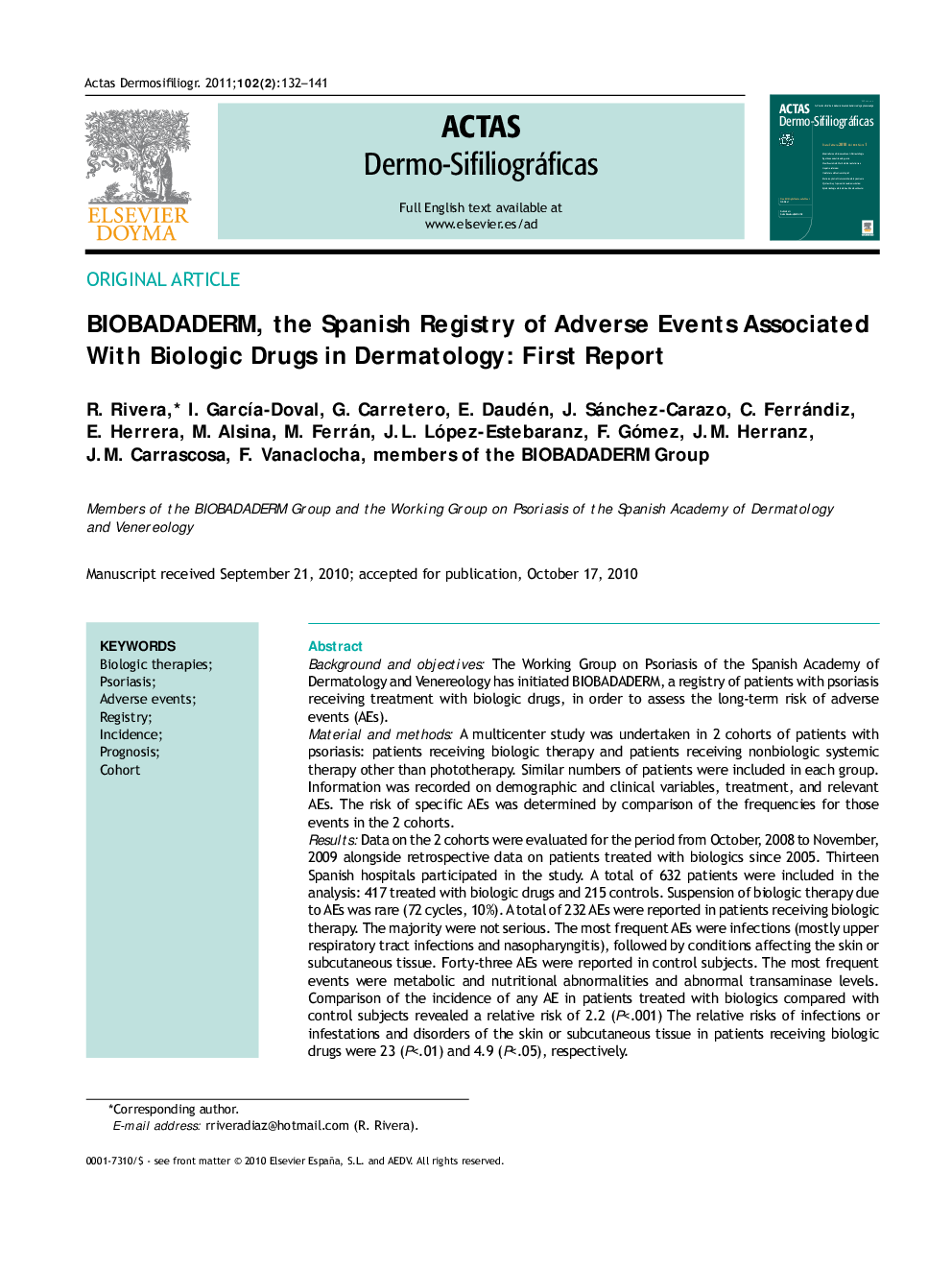| Article ID | Journal | Published Year | Pages | File Type |
|---|---|---|---|---|
| 3183446 | Actas Dermo-Sifiliográficas (English Edition) | 2011 | 10 Pages |
Background and objectivesThe Working Group on Psoriasis of the Spanish Academy of Dermatology and Venereology has initiated BIOBADADERM, a registry of patients with psoriasis receiving treatment with biologic drugs, in order to assess the long-term risk of adverse events (AEs).Material and methodsA multicenter study was undertaken in 2 cohorts of patients with psoriasis: patients receiving biologic therapy and patients receiving nonbiologic systemic therapy other than phototherapy. Similar numbers of patients were included in each group. Information was recorded on demographic and clinical variables, treatment, and relevant AEs. The risk of specific AEs was determined by comparison of the frequencies for those events in the 2 cohorts.ResultsData on the 2 cohorts were evaluated for the period from October, 2008 to November, 2009 alongside retrospective data on patients treated with biologics since 2005. Thirteen Spanish hospitals participated in the study. A total of 632 patients were included in the analysis: 417 treated with biologic drugs and 215 controls. Suspension of biologic therapy due to AEs was rare (72 cycles, 10%). A total of 232 AEs were reported in patients receiving biologic therapy. The majority were not serious. The most frequent AEs were infections (mostly upper respiratory tract infections and nasopharyngitis), followed by conditions affecting the skin or subcutaneous tissue. Forty-three AEs were reported in control subjects. The most frequent events were metabolic and nutritional abnormalities and abnormal transaminase levels. Comparison of the incidence of any AE in patients treated with biologics compared with control subjects revealed a relative risk of 2.2 (P<.001) The relative risks of infections or infestations and disorders of the skin or subcutaneous tissue in patients receiving biologic drugs were 23 (P<.01) and 4.9 (P<.05), respectively.ConclusionsPatients treated with biologic drugs had a greater number of AEs, particularly infections and skin conditions. Definitive conclusions, however, are difficult to draw due to the small number of patients included in the registry, particularly in the control cohort, and the short follow-up period. Differences in the percentages of events reported by the different hospitals reveal the difficulties associated with the concept of AEs in clinical practice and highlight the need to harmonize criteria in the future. Since the problems identified in this analysis should be overcome in future years, we expect BIOBADADERM to become an important source of information on the safety profile of biologic drugs in dermatology.
ResumenIntroducción y objetivosEl Grupo de Psoriasis de la Academia Española de Dermatología y Venereología (AEDV) ha puesto en marcha un registro de pacientes con psoriasis en tratamiento con agentes biológicos, con el objetivo de analizar el riesgo de acontecimientos adversos (AA) relevantes a largo plazo: BIOBADADERM.Material y métodosEs un estudio de cohortes multicéntrico, con una cohorte de pacientes con psoriasis en terapia biológica y otra cohorte control de pacientes con psoriasis con tratamiento sistémico no biológico, excluida la fototerapia, en una relación 1:1. Se registraron los datos básicos de cada paciente, de los tratamientos y de los AA relevantes. Se analizó el riesgo asociado a un AA concreto, comparando su frecuencia de aparición en ambas cohortes.ResultadosSe evaluaron los datos desde octubre de 2008 hasta noviembre de 2009 junto con datos retrospectivos desde 2005 sobre pacientes tratados con agentes biológicos. Participaron 13 hospitales de España. Se incluyeron 632 pacientes, 417 con biológicos y 215 controles. La suspensión del tratamiento biológico por AA fue poco frecuente (72 ciclos, 10%). Se comunicaron 232 AA en los pacientes con biológicos, la mayoría no graves, los más frecuentes las infecciones (la mayoría del tracto respiratorio superior/nasofaringitis), seguidos de los trastornos de la piel y el tejido subcutáneo. Entre los controles se notificaron 43 AA. Los más frecuentes fueron los trastornos del metabolismo y la nutrición y las alteraciones en las transaminasas. En términos de incidencia de AA, los biológicos presentaron un riesgo relativo (RR) de AA de 2,2 respecto a los controles (p < 0,001). En particular destacaron las infecciones e infestaciones (con un RR de 23 con p<0,01) y los trastornos de la piel y el tejido subcutáneo (RR: 4,9 con p < 0,05).ConclusionesLos pacientes tratados con fármacos biológicos presentan mayor número de AA que los controles, en particular en referencia a las infecciones y los trastornos de la piel. Sin embargo, debe tenerse en cuenta que tanto el tiempo de seguimiento como el limitado número de pacientes reclutados —en particular en el grupo de controles— impide extraer conclusiones definitivas. Por otro lado, la diferencia de porcentajes de AA referidos por los distintos centros pone de manifiesto la dificultad de la consideración del concepto de AA en la práctica clínica, siendo necesario homogeneizar los criterios. un a pesar de los problemas planteados, que deberán superarse en los próximos años, BIOBADADERM puede convertirse en la referencia obligada en la evaluación del perfil de seguridad de los fármacos biológicos en Dermatología.
